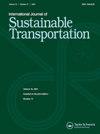高速公路施工作业区交通对环境的影响:框架与模拟
IF 3.9
3区 工程技术
Q2 ENVIRONMENTAL STUDIES
International Journal of Sustainable Transportation
Pub Date : 2024-08-02
DOI:10.1080/15568318.2024.2392624
引用次数: 0
摘要
在美国,高速公路上内燃机车辆的排放是造成全球变暖的主要原因。交通部门与路面相关的排放来自车辆使用的汽油和柴油,这些排放来自路面与车辆的相互作用(受路面状况影响),以及新路面材料的卡车运输和拆除。本研究的目的是制定一个框架,用于确定施工作业区(CWZ)对各种车辆造成的环境影响所导致的燃料使用量,并通过模拟高速公路维护和修复活动的交通封闭条件,对这些影响进行初步计算。研究包括两个常见的高速公路类别--高速公路/多车道高速公路和双车道高速公路。在不同的交通拥堵水平下,使用三个 CWZ 操作演示了该框架。模拟结果表明,在一条高速公路上,CWZ 交通拥堵严重,油耗增加了 85%,二氧化碳排放当量增加了 86%。将 CWZ 交通拥堵程度从严重(平均车速 5 英里/小时)改为中等(高速公路路段平均车速 25 英里/小时)后,高速公路的油耗降低了 40%。这项研究还包括在 CWZ 的一条双车道道路上使用试验车,该道路通常是交通流量较低的国道和县道,以便与 MOVES 中用于情景模拟的驾驶循环进行比较。试验车运行情景结果表明,在双车道道路上关闭单车道并使用试验车运行可能会多耗 13% 的燃油,原因是怠速时间和试验车后方车辆的缓慢行驶。本文章由计算机程序翻译,如有差异,请以英文原文为准。
Environmental impacts from traffic on highway construction work zones: Framework and simulations
Emissions from internal combustion engine vehicles on highways are the major contributors to global warming in the United States. Transportation sector pavement-related emissions come from gasolines and diesel use in vehicles from pavement-vehicle interaction, which is affected by pavement conditions, and by the trucking of new pavement materials and demolition. The objective of this study was to develop a framework for determining the fuel use resulting in environmental impacts caused by construction work zones (CWZs) on a range of vehicles and to produce initial calculations of these impacts by modeling traffic closure conditions for highway maintenance and rehabilitation activities. The study included two common highway categories—freeways/multi-lane highways and two-lane highways. The framework was demonstrated using three CWZ operations under different traffic congestion levels. In the simulation results for a freeway with a CWZ and heavy congestion, fuel consumption increased by 85% and the carbon-dioxide equivalent emissions increased by 86%. Changing CWZ traffic congestion from heavy (average speed 5 mph) to medium (average speed 25 mph for a freeway section) reduced fuel consumption by 40% on a freeway. This study also included use of a pilot car in a CWZ on a two-lane road typical of lower traffic volume state highways and county roads to compare with the drive cycles in MOVES used for the scenarios. The pilot-car operation scenario results indicate that a one-lane closure with pilot-car operation on a two-lane road might consume 13% excess fuel because of idling time and the slow movement of vehicles following the pilot car.
求助全文
通过发布文献求助,成功后即可免费获取论文全文。
去求助
来源期刊
CiteScore
8.90
自引率
2.60%
发文量
56
期刊介绍:
The International Journal of Sustainable Transportation provides a discussion forum for the exchange of new and innovative ideas on sustainable transportation research in the context of environmental, economical, social, and engineering aspects, as well as current and future interactions of transportation systems and other urban subsystems. The scope includes the examination of overall sustainability of any transportation system, including its infrastructure, vehicle, operation, and maintenance; the integration of social science disciplines, engineering, and information technology with transportation; the understanding of the comparative aspects of different transportation systems from a global perspective; qualitative and quantitative transportation studies; and case studies, surveys, and expository papers in an international or local context. Equal emphasis is placed on the problems of sustainable transportation that are associated with passenger and freight transportation modes in both industrialized and non-industrialized areas. All submitted manuscripts are subject to initial evaluation by the Editors and, if found suitable for further consideration, to peer review by independent, anonymous expert reviewers. All peer review is single-blind. Submissions are made online via ScholarOne Manuscripts.

 求助内容:
求助内容: 应助结果提醒方式:
应助结果提醒方式:


